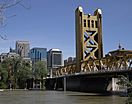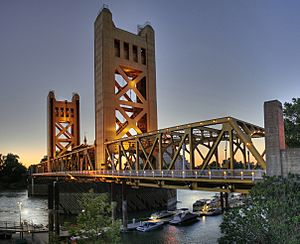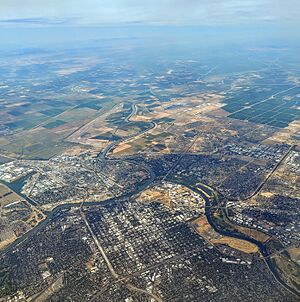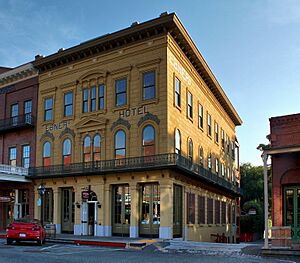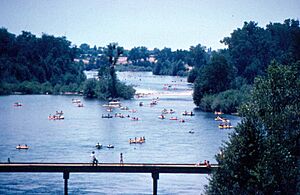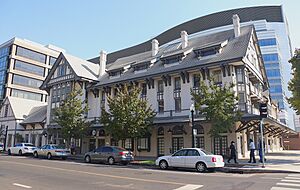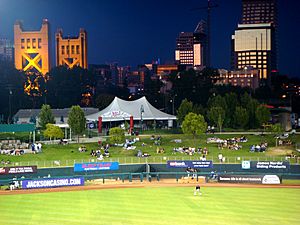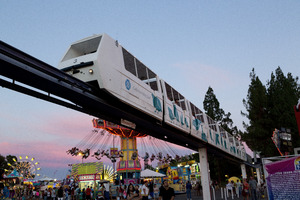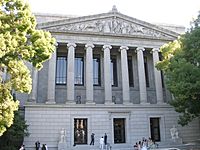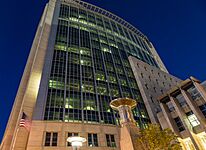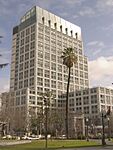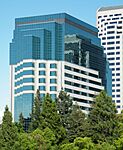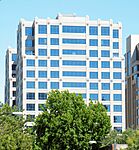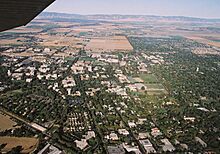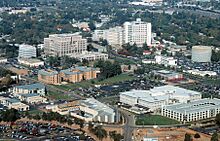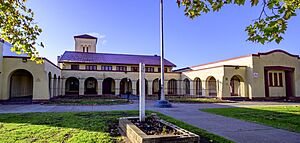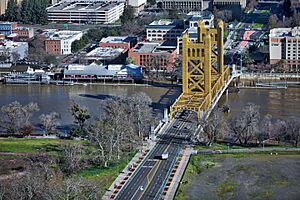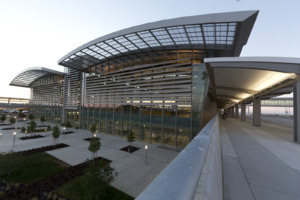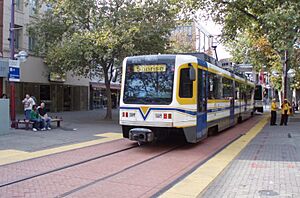Sacramento, California facts for kids
Quick facts for kids
Sacramento
|
|||
|---|---|---|---|
|
Downtown and the Sacramento River
California Supreme Court
|
|||
|
|||
| Nickname(s):
"Sactown", "Sac", "City of Trees", "River City", "Camellia City"
|
|||
| Motto(s): | |||
| Country | United States | ||
| State | California | ||
| County | Sacramento
|
||
| Region | Sacramento Valley | ||
| CSA | Sacramento-Roseville | ||
| MSA | Sacramento–Roseville–Arden-Arcade | ||
| Laid out | December 1848 | ||
| Incorporated | February 27, 1850 | ||
| Chartered | 1920 | ||
| Named for | Sacrament of the Holy Eucharist | ||
| Government | |||
| • Type | Council–Manager | ||
| • Body | Sacramento City Council | ||
| Area | |||
| • City | 100.70 sq mi (260.81 km2) | ||
| • Land | 98.61 sq mi (255.40 km2) | ||
| • Water | 2.09 sq mi (5.41 km2) 2.19% | ||
| Elevation | 26 ft (8 m) | ||
| Population
(2020)
|
|||
| • City | 524,943 | ||
| • Rank | 35th in the United States 6th in California |
||
| • Density | 5,323.4/sq mi (2,055.4/km2) | ||
| • Urban | 1,946,618 (US: 25th) | ||
| • Urban density | 4,163.2/sq mi (1,607.4/km2) | ||
| • Metro | 2,463,127 (US: 26th) | ||
| Demonym(s) | Sacramentan | ||
| Time zone | UTC−08:00 (PST) | ||
| • Summer (DST) | UTC−07:00 (PDT) | ||
| ZIP Codes |
94203–94209, 94211, 94229–94230, 94232, 94234–94237, 94239–94240, 94244–94245, 94247–94250, 94252, 94254, 94256–94259, 94261–94263, 94267–94269, 94271, 94273–94274, 94277–94280, 94282–94285, 94287–94291, 94293–94299, 95811–95838, 95840–95843, 95851–95853, 95860, 95864–95867, 95894, 95899
|
||
| Area code | 916 and 279 | ||
| FIPS code | 06-64000 | ||
| GNIS feature IDs | 1659564, 2411751 | ||
Sacramento (pronounced SAK-rə-MEN-toh) is the capital city of California, a state in the United States. It is also the main city of Sacramento County. Sacramento is located where the Sacramento River and American River meet, in the Sacramento Valley. It is the fourth-largest city in Northern California and the sixth-largest in the entire state. In 2020, about 524,943 people lived there. The larger Sacramento area, including nearby towns, has about 2.46 million residents.
Before Spanish explorers arrived, the area was home to Native American tribes like the Nisenan and Maidu. In 1808, a Spanish explorer named Gabriel Moraga named the Sacramento River after a religious term, "the Blessed Sacrament." Later, in 1839, a Swiss-born Mexican citizen named John Sutter started a settlement called Sutter's Fort. After California became part of the U.S. in 1848, the city of Sacramento was officially formed in 1850. It became the permanent state capital in 1854.
Sacramento is where California's laws are made and where the governor works. It is one of the fastest-growing big cities in California. It is also an important center for education, with California State University, Sacramento and UC Davis nearby. The city is also a major hub for healthcare. Many people visit Sacramento each year to see its museums, historic sites like Old Sacramento State Historic Park, and the Sacramento Convention Center Complex.
Contents
History of Sacramento
Sacramento has a rich history, from its early days as a Native American homeland to becoming a bustling state capital.
Early Native American Life
For thousands of years, Native American tribes like the Nisenan, Modoc, and Plains Miwok lived in the Sacramento area. They gathered acorns from oak trees, along with fruits, seeds, and roots. These tribes lived off the land long before settlers arrived.
Spanish Exploration
In 1808, Spanish explorer Gabriel Moraga explored the valley and named the Sacramento River. A writer on his trip described the beautiful area with trees and clear water. They named the river after "the Most Holy Sacrament," a religious term.
Mexican Settlement
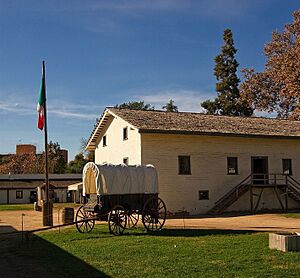
John Sutter arrived in the area in 1839. He received a large land grant from Mexico and built Sutter's Fort, a strong adobe structure. He called his settlement New Helvetia, a name inspired by Switzerland. Sutter's Fort became a popular stop for pioneers traveling west. By 1847, Sutter had many fruit trees, starting the area's farming industry. He also hired James Marshall to build a sawmill.
The Gold Rush and City Growth
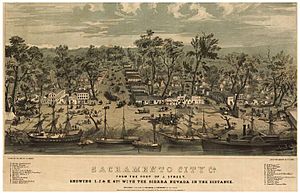
In 1848, gold was discovered at Sutter's Mill, about 50 miles northeast of the fort. This discovery brought many gold seekers to the area, causing the population to grow quickly. John Sutter's son, John Sutter Jr., and Samuel Brannan started planning the city of Sacramento in December 1848, south of his father's fort. They named the new city "Sacramento City" after the river.
Sacramento became an official city on February 27, 1850. It is the oldest incorporated city in California. The city faced many challenges early on, including a major flood in January 1850. To protect the city, levees (walls to hold back water) were built. However, these early levees sometimes broke, causing more floods. In November 1852, a huge fire destroyed most of the city's buildings. Despite these difficulties, Sacramento grew rapidly because of its location near the gold fields.

In 1854, the California State Legislature moved to Sacramento, making it the permanent state capital. The beautiful California State Capitol building was started in 1860 and finished in 1874. Sacramento became an important center for transportation, serving as the western end of the Pony Express and later the First transcontinental railroad.
Modern Sacramento
Sacramento has continued to grow and change over the years. In 1964, the city of North Sacramento joined with Sacramento, increasing its population. The city also expanded into areas like Natomas.
During World War II, a temporary center called the Sacramento Assembly Center was built to house Japanese Americans who were moved from their homes. After the war, some Japanese American families lived there temporarily.
The Port of Sacramento opened in 1949, allowing large ships to reach the city. In 1963, the first ocean-going ship since 1934 arrived at the port.
Sacramento has seen its economy grow beyond just government jobs. Healthcare, manufacturing, and technology have become important industries. The city also built a new sports arena, Golden 1 Center, which opened in 2016.
Geography and Environment
Sacramento covers about 100 square miles. Most of this area is land, with a small portion being water.
Rivers and Flood Control
The city is located where the Sacramento River and American River meet. It has a deep-water port that connects to the San Francisco Bay through a channel. Much of the land west of the city is kept as a flood control area called the Yolo Bypass. This helps protect Sacramento from floods, which have been a challenge in the past.
Sacramento's Trees
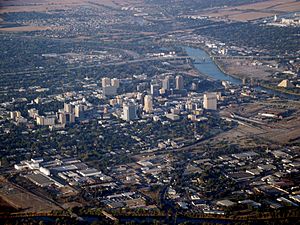
Sacramento is often called the "City of Trees" because it has so many trees. It is said to have more trees per person than any other city in the world. The city was first called the "City of Plains" because it had few trees. But soon, many trees like cottonwoods and eucalyptus were planted. Later, other trees like elms and palms were added. In 1978, it was the first U.S. city to be named a "City of Trees" by the Arbor Day Foundation.
Today, Sacramento has a lot of tree cover, much more than many other big cities. The most common tree is the London plane. The city is also adding new types of trees to help with future climate changes. A project using Google Maps data ranked Sacramento as the greenest city among 15 U.S. cities and third globally.
A water tower in Sacramento used to have the slogan "City of Trees." In 2017, it was repainted to say "America's Farm-to-Fork Capital." After many people protested, officials decided to include both slogans on the tower.
City Areas
Sacramento has many different neighborhoods, each with its own feel.
Capitol Mall
Capitol Mall is a main road that connects West Sacramento to Downtown Sacramento. It features important landmarks like the Tower Bridge, Old Sacramento, and the California State Capitol Building. This area is known as the city's business district, with tall buildings and major companies. It also hosts big events like the annual Farm to Fork Festival.
Downtown Commons
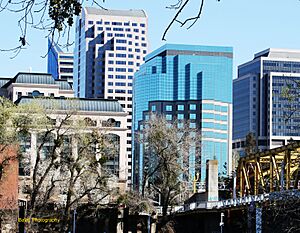
Downtown Commons, also known as DOCO, is a newer area that opened in 2016. It is next to the Golden 1 Center sports arena. DOCO has a tall building called The Sawyer, which includes a hotel and apartments. It also has shops, restaurants, and an IMAX movie theater.
Downtown Sacramento
Downtown Sacramento is home to the SAFE Credit Union Convention Center, Sacramento City Hall, the main library, and K Street. K Street is a historic area with apartments, shops, and old buildings. Many hotels are also located downtown.
East Sacramento
East Sacramento is a neighborhood between Midtown and Sacramento State University. It is famous for McKinley Park and the "Fabulous Forties," an area with some of the city's largest and most unique homes. Former California Governor Ronald Reagan lived here.
Old Sacramento
Old Sacramento is the oldest part of the city, besides Sutter's Fort. It has cobblestone streets and many historic buildings from the 1850s and 1860s. These buildings have been saved and restored. It is a popular place for tourists, who can ride historic steam trains and horse-drawn carriages.
Climate and Weather
Sacramento has a Mediterranean climate, meaning it has hot, long, and dry summers, and cool winters with a good amount of rain. Most of the rain falls from November to April. Summer heat is often cooled by a "delta breeze" from the San Francisco Bay, which makes nights cooler.
The foggiest months are December and January. This "tule fog" can be very thick, making it hard to see and drive. Snowfall is rare in Sacramento because it is only about 25 feet above sea level. When it does snow, it usually melts quickly.
Sacramento is known for being one of the sunniest places on Earth from June through September. July is especially sunny, with about 98% of possible sunshine.
People of Sacramento
| Historical population | |||
|---|---|---|---|
| Census | Pop. | %± | |
| 1850 | 6,820 | — | |
| 1860 | 13,785 | 102.1% | |
| 1870 | 16,283 | 18.1% | |
| 1880 | 21,420 | 31.5% | |
| 1890 | 26,386 | 23.2% | |
| 1900 | 29,282 | 11.0% | |
| 1910 | 44,696 | 52.6% | |
| 1920 | 65,908 | 47.5% | |
| 1930 | 93,750 | 42.2% | |
| 1940 | 105,958 | 13.0% | |
| 1950 | 137,572 | 29.8% | |
| 1960 | 191,667 | 39.3% | |
| 1970 | 257,105 | 34.1% | |
| 1980 | 275,741 | 7.2% | |
| 1990 | 369,365 | 34.0% | |
| 2000 | 407,018 | 10.2% | |
| 2010 | 466,488 | 14.6% | |
| 2020 | 524,943 | 12.5% | |
| 2024 (est.) | 535,798 | 14.9% | |
| U.S. Decennial Census 2010–2020 |
|||
Sacramento is known as one of "America's Most Diverse Cities." This means many different ethnic and racial groups live there, and they often live together in neighborhoods.
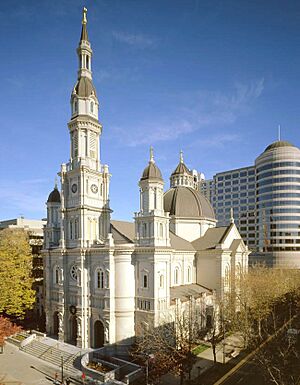
In 2020, Sacramento had a population of 524,943. About 34.8% of the people were White, 13.2% African American, 1.4% Native American, 19.9% Asian, and 1.6% Pacific Islander. About 28.8% of the population was of Hispanic or Latino background. The largest Asian groups in Sacramento are Chinese, Filipino, Indian, Vietnamese, Hmong, and Japanese.
Sacramento's Economy
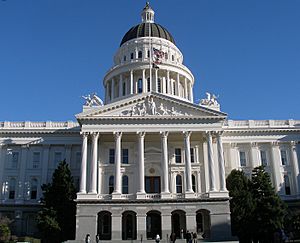
Sacramento's economy has historically relied a lot on the state and federal governments, with many people working in public jobs. However, in recent years, the city's economy has become more varied. Industries like healthcare, manufacturing, and technology are growing.
Many important companies are based in Sacramento or the surrounding area, including Sutter Health, Blue Diamond Growers, and Raley's Supermarkets. Other big companies like Amazon, Apple, and Intel also have operations in Sacramento.
The Port of Sacramento has faced challenges due to competition from other ports. However, during the Vietnam War, it was a major route for military supplies.
Culture and Arts
Sacramento has a lively culture with many museums, performing arts groups, and a growing food scene.
Museums to Explore
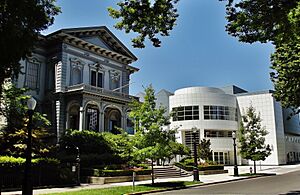
Sacramento is home to 32 museums. The Crocker Art Museum is the oldest public art museum west of the Mississippi River. It was expanded in 2010 and now has a huge amount of exhibit space.
Other interesting museums include the Governor's Mansion State Historic Park, a large Victorian house where 14 California Governors lived. The California Museum tells the history of California and features the California Hall of Fame. The California State Capitol Museum offers free tours of the capitol building and displays historical items.
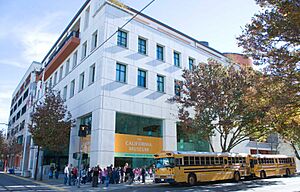
The California State Railroad Museum in Old Sacramento has historical exhibits and offers rides on old steam trains. The California Automobile Museum shows cars from 1880 to 2006. The Aerospace Museum of California at McClellan Air Force Base displays over 40 aircraft. The Sacramento History Museum focuses on the city's history from before the gold rush to today. In 2021, the Museum of Science and Curiosity (MOSAC) opened in a historic power station building.
Every year, Sacramento holds a Museum Day on the first Saturday of February, where 26 museums offer free admission.
Performing Arts

The Sacramento Ballet, Sacramento Philharmonic Orchestra, and Sacramento Opera perform at the SAFE Credit Union Performing Arts Center.
Sacramento has several major theaters. The Sacramento Convention Center Complex manages the SAFE Credit Union Performing Arts Center and Memorial Auditorium. The Wells Fargo Pavilion is a large theater that hosts Broadway shows. The Eagle Theatre in Old Sacramento is a rebuilt version of California's oldest permanent theater.
Visual Arts
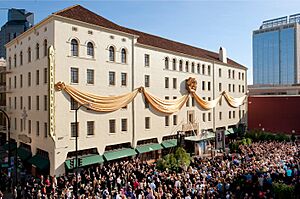
The Sacramento Metropolitan Arts Commission supports many art programs in the city. The Sacramento Second Saturday Art Walk is a popular event where local art galleries stay open late on the second Saturday of each month.
Sacramento is also home to the Wide Open Walls Festival. Since 2016, artists from around the world have created over 140 murals across the city as part of this festival.
Music Scene
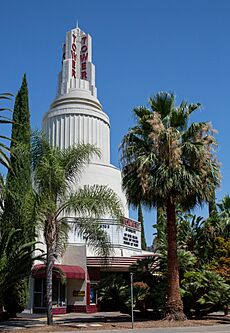
Tower Records started in Sacramento. The city has a strong classical music scene with groups like the Sacramento Philharmonic Orchestra and the Sacramento Youth Symphony.
Sacramento is also known for its Dixieland jazz. The city used to host the Sacramento Jazz Jubilee every Memorial Day weekend. Many rock, hardcore, and metal bands, like Deftones and Papa Roach, are from the Sacramento area.
The city hosts several music festivals each year, including the four-day Aftershock Festival at Discovery Park, which features famous bands. Other festivals include the GoldenSky Festival for country music and the Sol Blume festival for soul and R&B.
Food and Drink
Since 2012, Sacramento has been known as "America's Farm-to-Fork Capital." This means many restaurants get their food directly from local farms. The city has an annual Farm-to-Fork festival to celebrate this.
Sacramento also has a growing craft beer scene, with over 60 breweries in the region. It hosts the California Beer Craft Summit, which includes a large beer festival downtown. The city is also recognized for its coffee culture, with many local coffee shops.
Sports and Recreation
Sacramento is home to the Sacramento Kings, a professional basketball team in the National Basketball Association. The Kings moved to Sacramento in 1985. In 2013, there was a big effort by Mayor Kevin Johnson and local fans to keep the team in Sacramento, and they succeeded.
The Sacramento Republic FC soccer team started playing in 2014 and won the USL championship in their first season. They play at Papa Murphy's Park.
Minor league baseball is played by the Sacramento River Cats, who are connected to the San Francisco Giants. They play at Sutter Health Park in West Sacramento. The Athletics (a Major League Baseball team) are playing at Sutter Health Park from 2025 to 2027 while their new stadium is built.
The Sacramento State Hornets play college football at Hornet Stadium.
Sacramento used to have a professional women's basketball team, the Sacramento Monarchs, who won the WNBA Championship in 2005.
Parks and Outdoor Fun
Sacramento has a huge park system with over 5,000 acres of parkland. In 2013, Sacramento's park system was ranked among the best in the U.S.
Downtown Sacramento has many smaller parks like Crocker Park and Roosevelt Park, which have basketball courts, playgrounds, and host farmers markets. Cesar Chavez Plaza is a popular spot for concerts and gatherings. Capitol Park, surrounding the California State Capitol, is a 40-acre park with many types of trees and memorials.
William Land Park is a very popular park with several attractions. The Sacramento Zoo is home to over 400 animals. The park also has Funderland, a small amusement park, and Fairytale Town, which is visited by many children each year.
The California State Fair is held in Sacramento every year at the end of summer. It attracts over a million visitors. The Jedediah Smith Memorial Trail runs along the American River, offering a great place for cyclists and horseback riders.
Government and Education
Sacramento is important because it is both the capital of California and the main city of Sacramento County.
City Government
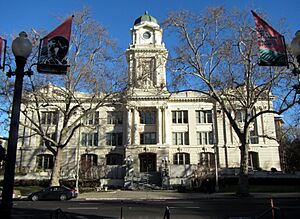
The city of Sacramento has its own government, led by a mayor and a city council with 8 members. The current mayor is Kevin McCarty. The city also has departments like the Sacramento Police Department and Sacramento Fire Department.
California State Government
As the capital, Sacramento is where the government of California is located. The California State Capitol building is where the governor and the state legislature work. Many state agencies also have their offices in Sacramento.
- Government buildings in Sacramento
Colleges and Universities
The Sacramento area offers many choices for higher education.
Sacramento State University was founded in 1947. Its mascot is the hornet, and its colors are green and gold. The campus is located along the American River.
The University of California, Davis (UC Davis) has a campus nearby in Davis, but its medical center and some graduate programs are in Sacramento.
The Los Rios Community College District includes several two-year colleges in the area: American River College, Cosumnes River College, and Sacramento City College.
The University of the Pacific has a campus in Sacramento that includes the McGeorge School of Law and other graduate programs.
Schools for Kids
Sacramento has several public school districts, including the Sacramento City Unified School District, Natomas Unified School District, and Elk Grove Unified School District.
There are also many private schools, including Catholic schools like Saint Patrick Academy, and other independent schools like Sacramento Country Day School. The Sacramento Waldorf School is a large school located in Fair Oaks.
The Sacramento Public Library system has 28 branches throughout the area.
Transportation in Sacramento
Sacramento is easy to get around by car, train, bus, and even bicycle.
Roads and Highways
Several major highways serve Sacramento. Interstate 80 connects Sacramento to San Francisco in the west and Reno, Nevada, in the east. U.S. Highway 50 heads east towards South Lake Tahoe. Interstate 5 runs through Sacramento, going north towards Redding and south towards Los Angeles.
Many neighborhoods in Sacramento are great for biking. The city has also worked to make sidewalks and facilities easy to use for people in wheelchairs.
Train Services
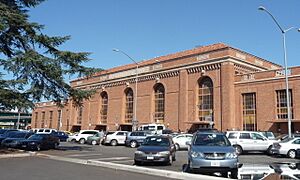
Amtrak provides passenger train service to Sacramento at the Sacramento Valley Rail Station. This station is near Old Town Sacramento.
- The Capitol Corridor train connects Sacramento to its suburbs and the San Francisco Bay Area.
- The San Joaquins train goes south through California's Central Valley to Bakersfield.
- The Coast Starlight train offers scenic trips north to Seattle and south to Los Angeles.
- The California Zephyr train travels daily to the east, serving cities like Reno, Salt Lake City, Denver, and Chicago.
Sacramento's Amtrak station is the second busiest in California.
Airport and Local Transit
Sacramento International Airport is about 10 miles northwest of downtown. It has flights to many U.S. cities, including Hawaii, and to Mexico and Canada. Southwest Airlines is the main airline there.
The city and its suburbs are served by the Sacramento Regional Transit District (SacRT), which has buses and a light-rail system. The light-rail system has three lines (Blue, Gold, and Green) and many stations, connecting different parts of the city. There are plans to extend the Green Line to the airport.
Bicycling is very popular in Sacramento because of its mild climate and flat land. Many people bike to work from nearby communities using special bike paths.
International Connections

Sacramento has 14 sister cities around the world. These partnerships help build friendships and understanding between different cultures.
- Ashkelon, Israel
- Bethlehem, Palestine
- Chişinău, Moldova
- Hamilton, New Zealand
- Jinan, China
- Liestal, Switzerland
- Manila, Philippines
- Matsuyama, Japan
- Mexicali, Mexico
- Pasay, Philippines
- San Juan de Oriente, Nicaragua
- Yongsan-gu, South Korea
- Valencia, Spain
- Sumy, Ukraine
See also
 In Spanish: Sacramento (California) para niños
In Spanish: Sacramento (California) para niños






